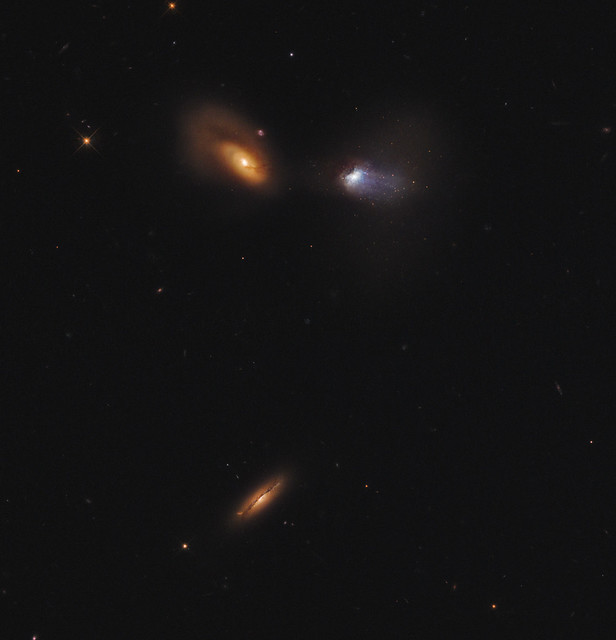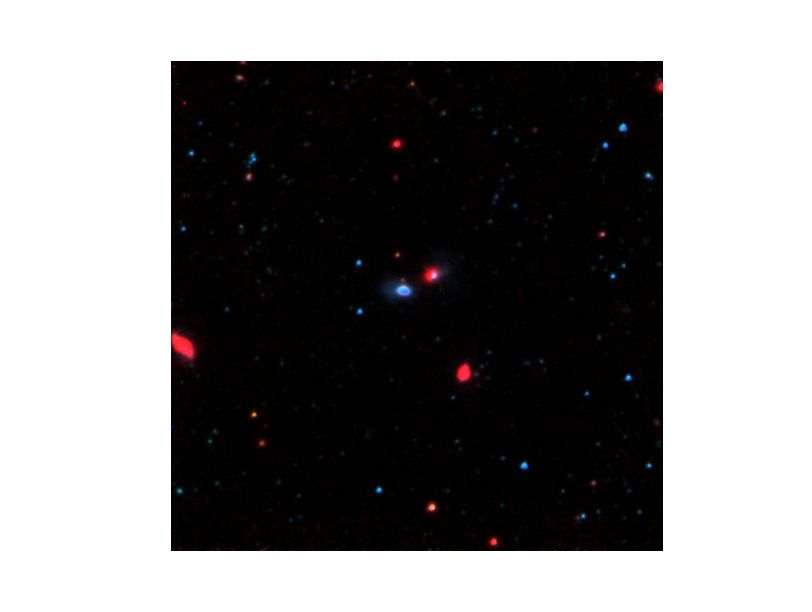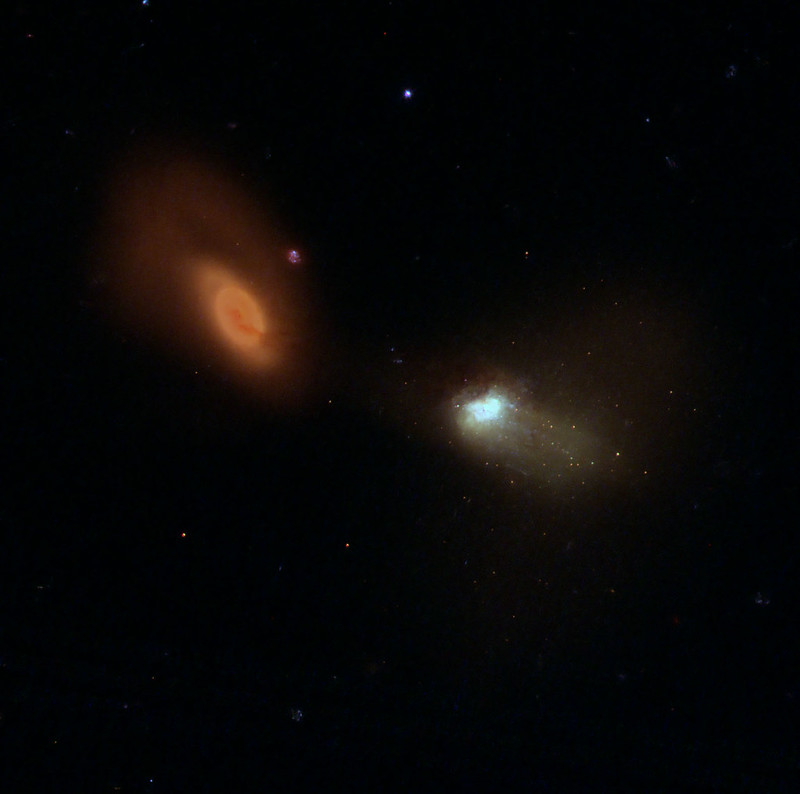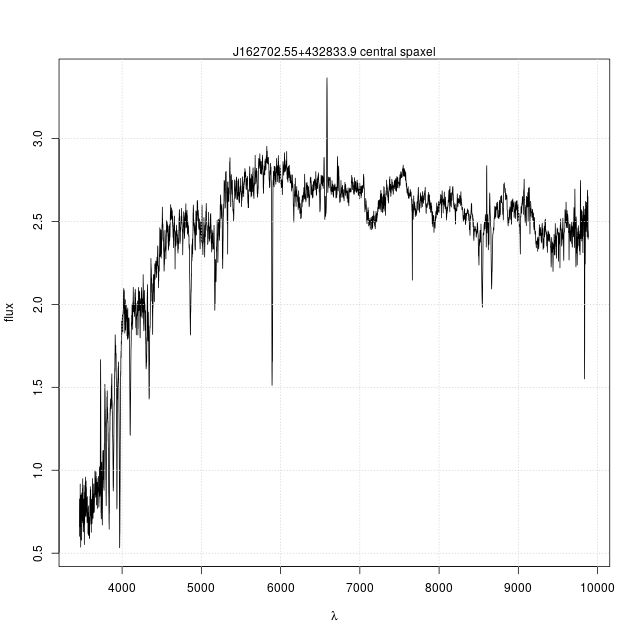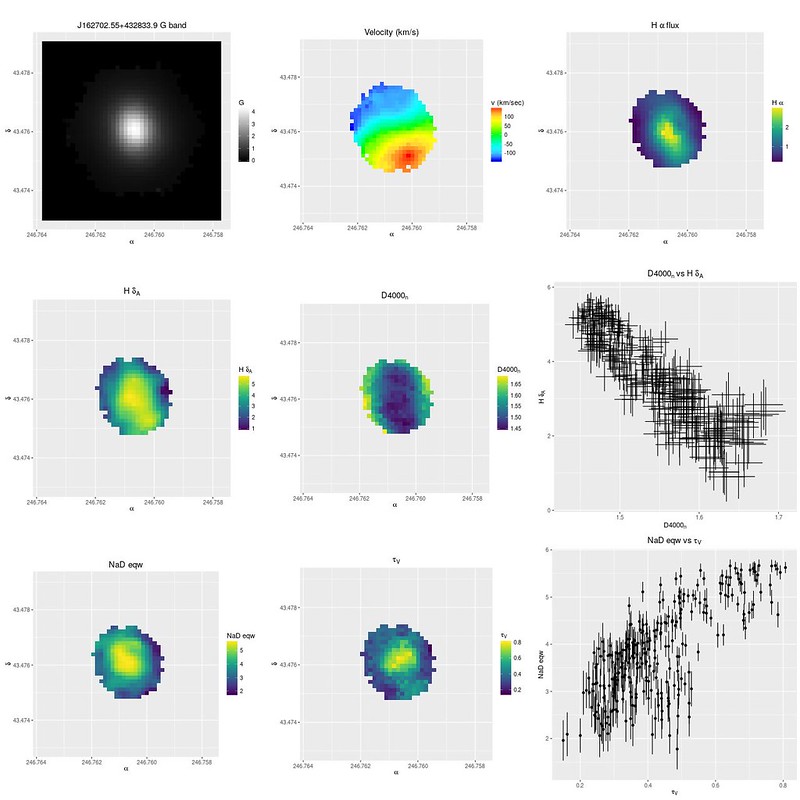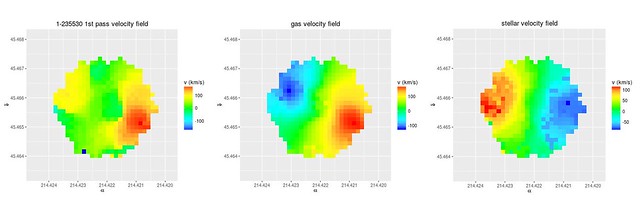MANGA targeting?
-
 by
mlpeck
by
mlpeck
I'm hoping @klmasters will stop by and comment, since she's on at least one Manga planning committee.
For background, about 5-6% of K+A (aka E+A, etc.) galaxies that were identified in SDSS releases up to DR7 have catastrophic redshift measurement errors in the final data release. For example the most comprehensive catalog published to date by Melnick & dePropris (2013) has 808 objects, of which 40 have redshift errors in DR12. What seems to be a good predictor of failure of the SDSS redshift pipeline is the fraction of young stars contributing to the spectrum, that is how recently star formation has been terminated. Here are two examples that are in the redshift range that Manga is targeting and that might otherwise qualify as candidates.
I Zw 136 (z = 0.034)
SDSS spectrum of the K+A galaxy (note the measured redshift!):
and its companion:
This galaxy pair has been studied with long slit spectroscopy and the K+A galaxy (only) with integral field spectroscopy, but there's some basic disagreement about the spectroscopic properties.
This second galaxy has not been studied in detail and the only historical catalog designation I could find is KUG 1420+231. Its correct redshift is z=0.0325
Spectrum:
This had the largest percentage of young stars in Melnick & dePropris' models and it lacks the spectral markers of an older stellar population, which indicates that there was an exceptionally strong burst of star formation that appears to have been recently shut down.
There is also an SDSS spectrum for the other end of the galaxy as indicated, but it doesn't show up when you click on it in Navigate.
Posted
-
 by
mlpeck
by
mlpeck
HST image of I Zw 136:
Discussed by dePropris & Melnick 2014.
Image found on flickr: https://www.flickr.com/photos/stephen63/with/10078038833/
HST imaging was derived from proposal 11643, PI Ann Zabludoff
Posted
-
 by
mlpeck
by
mlpeck
I'm going to bump this again (and again, at least until I'm completely convinced that I'm talking only to myself).
I Zw 136 was a Spitzer target as well under two different observing proposals. I've downloaded the IRAC images, but may not have time to produce pseudo-color composites for a while (ditto HST images).
There are a couple notable features of the HST image where spatially resolved spectroscopy would be valuable:
- There's what appears to be a star forming dwarf galaxy superimposed on the northern edge of the disturbed disk galaxy. Presumably it's in the foreground since there seems to be copious amounts of dust in the disk -- if it's actually in the disk galaxy it's unusually located and it's also the only prominently star forming area in what appears to be otherwise a passively evolving galaxy. These galaxies by the way belong to a small group that I don't think has been noted in the literature. The edge on disk galaxy to the south is in the same redshift range, and there's another to the north.
- dePropris & Melnick noted long nearly linear streams of star clusters trailing to the west of the central part of the K+A galaxy. These couldn't be resolved at SDSS resolution of course, but the kinematics could be interesting as could evidence for or against age gradients of the stellar population.
- Is there a hidden ongoing starburst in the K+A galaxy? Maybe hard to say with optical spectroscopy, but the SDSS fiber was positioned right at the highest surface brightness part of the galaxy and there's a rather sharp edged cloud of dust just to the east.
Posted
-
 by
Budgieye
moderator
by
Budgieye
moderator
Are you wanting to recommend these galaies for otation analysis in MaNGA? I don't think the @ function is working in our version of Talk.
I like the Hubble images.
Posted
-
 by
mlpeck
by
mlpeck
Budgieye:
Yes I am recommending that these galaxies be considered as targets for MaNGa. If the final data release of SDSS is being used as the basis for sample selection both of these would be missed because of egregious redshift measurement errors in DR8+, while both of them are in fact in the target redshift range and would otherwise be compatible with their science goals.
I don't think the @ function is working
I guess I'll have to tweet @KarenLMasters and @ManGASurvey then. Thanks for the heads up.
Posted
-
 by
zutopian
by
zutopian
According to below paper, SDSS-I redshifts are used for sample selection!
SDSS-I isn't DR8-12, as far as I know! If so: I guess, that there is no problem!Overview of the SDSS-IV MaNGA Survey: Mapping Nearby Galaxies at Apache Point Observatory
Authors: Kevin Bundy, Matthew A. Bershady, David R. Law, Renbin Yan, Niv Drory, Nicholas MacDonald, David A. Wake, Brian Cherinka, José R. Sánchez-Gallego, Anne-Marie Weijmans, Daniel Thomas, Christy Tremonti, Karen Masters, et al.We present an overview of a new integral field spectroscopic survey called MaNGA (Mapping Nearby Galaxies at Apache Point Observatory), one of three core programs in the fourth-generation Sloan Digital Sky Survey (SDSS-IV) that began on 2014 July 1. MaNGA will investigate the internal kinematic structure and composition of gas and stars in an unprecedented sample of 10,000 nearby galaxies. (...)
Targets are selected with stellar mass greater than 1e9 Msun using SDSS-I redshifts and i-band luminosity to achieve uniform radial coverage in terms of the effective radius, an approximately flat distribution in stellar mass, and a sample spanning a wide range of environments. Analysis of our prototype observations demonstrates MaNGA's ability to probe gas ionization, shed light on recent star formation and quenching, enable dynamical modeling, decompose constituent components, and map the composition of stellar populations. MaNGA's spatially resolved spectra will enable an unprecedented study of the astrophysics of nearby galaxies in the coming 6 yr.(Submitted on 3 Dec 2014)
http://arxiv.org/abs/1412.1482Posted
-
 by
JeanTate
in response to zutopian's comment.
by
JeanTate
in response to zutopian's comment.
The designations SDSS-I, SDSS-II, and SDSS-III (there's no -IV, as far as I know) refer to the major funding phases, I think, which also reflects the main scientific aims. They are not directly related to the Data Releases. For example, the BOSS and APOGEE spectra are part of either -II or -III (if memory serves).
Posted
-
 by
mlpeck
by
mlpeck
Here's a first amateurish attempt at a false color composite of I Zw 136 from the Spitzer IRAC camera. This was constructed from the 3.6, 4.5 and 8 um images. Starlight is usually the dominant source of flux at 3.6 um, while warm dust and complex hydrocarbon molecules called "PAHs" become more important at longer wavelengths. So in this picture the apparently passively evolving and old disk galaxy to the east looks blue-white while, for example, the dusty edge on spiral to the south is bright red. And, what would have been a surprise to me if I hadn't seen the HST image first, the eastern edge of the K+A galaxy is also dusty, with the bright area that was targeted by SDSS and the tidal streams trailing off to the west dominated by starlight.
Jean, SDSS-IV is the current round of observations.
Posted
-
 by
zutopian
in response to JeanTate's comment.
by
zutopian
in response to JeanTate's comment.
The designations SDSS-I, SDSS-II, and SDSS-III (there's no -IV, as far as I know) refer to the major funding phases, I think, which also reflects the main scientific aims. They are not directly related to the Data Releases. For example, the BOSS and APOGEE spectra are part of either -II or -III (if memory serves).
It seems, that they actually are directly related to the Data Releases!: I found following information on the website of SDSS.:
•SDSS-I/II acknowledgment (SDSS-I, SDSS-II Legacy, SDSS-II SEGUE-1, SDSS-II Supernova, DR 1-7)
•SDSS-III acknowledgment (APOGEE-1, BOSS, MARVELS, SEGUE-2, DR 8-12)
• SDSS-IV acknowledgment (APOGEE-2, eBOSS, MaNGA)http://www.sdss.org/collaboration/citing-sdss/
SDSS-I/II refers to DR 1-7 and SDSS-III refers to DR 8-12!
According to the previously mentioned paper by Bundy el. al. (MANGA Survey), SDSS-I redshifts are used for sample selection!
The redshifts of DR 8-12 (SDSS III) aren't used! Hence I conclude, that there is actually no problem related to MANGA targeting!Posted
-
 by
mlpeck
by
mlpeck
Zooming in on I Zw 136 and its companion. I'm not sure how much information this adds and I'm still a long way from mastering the art of turning HST imaging into pretty pictures, but the resolution is a little higher than the version above (still only half the size of the original). I also tried to bring out lower surface brightness details.
This might be my imagination but there appears to be a bridge of luminous material and dust extending from the eastern part of the K+A galaxy right into the nucleus of the disk galaxy. It may be clearer in this picture too that there appears to be a dwarf galaxy with HII regions (?) superimposed on the outer part of the disk galaxy. Note that it can be seen in the Spitzer image above as a point source with quite different IR colors than the old disk galaxy.
There are also a number of faint but partially resolved systems visible, presumably dwarf galaxies within the group.
Flickr photostream here https://www.flickr.com/photos/27794530@N08/ if you want to see the full resolution version (or vacation pix).
Posted
-
 by
mlpeck
by
mlpeck
Well, DR13 is officially out today with the first public MaNGA release. It seems the oddly shaped galaxy with the catalog designation KUG 1420+231 (IAU name J142256.66+225435.7) is on the MaNGA target list. I'm still trying to figure out exactly what the bitmask values mean in the target catalog -- the manga_target1 value is 4672, which appears to indicate it was selected as a target during the 2014 commisioning, but the observed flag is False while the ranflag is True. It's not clear to me from a quick read of the explanatory material if that means it will certainly be observed or if it might just be randomly selected in the future.
I Zw 136 does not appear in the target catalog, even though it's right in the middle of the region of the sky that was most intensely targeted in the first few observing seasons. That's a shame since the fact that it has been observed by both HST and Spitzer (also Subaru) indicates that it's of considerable scientific interest to somebody.
Time for a little more thorough digging. There have to be a few of Melnick & dePropris' K+A galaxies in the first public release.
Posted
-
 by
mlpeck
in response to mlpeck's comment.
by
mlpeck
in response to mlpeck's comment.
There have to be a few of Melnick & dePropris' K+A galaxies in the
first public release.And it turns out there's just one in the first public release. There are 33 total from Melnick & dePropris' catalog of 808 K+A galaxies in the MaNGA target catalog, and 4 of those are marked as observed. There are 42561 targets in this version of the target catalog, the stated goal is to get data for ~10,000 galaxies, so presumably we should expect to get another 4 or so observed. Or am I misinterpreting what the MaNGA target catalog contains?
Here's the SDSS finder chart image for the one K+A galaxy in DR13. A fairly impressive shell galaxy:
Posted
-
 by
zutopian
in response to mlpeck's comment.
by
zutopian
in response to mlpeck's comment.
I Zw 136 does not appear in the target catalog, even though it's right in the middle of the region of the sky that was most intensely targeted in the first few observing seasons. That's a shame since the fact that it has been observed by both HST and Spitzer (also Subaru) indicates that it's of considerable scientific interest to somebody.
There are some MaNGA Ancillary Target Programs.:
MaNGA Ancillary Targets
http://www.sdss.org/dr13/manga/manga-target-selection/ancillary-targets/Close Pairs and Mergers
("Observations of galaxies in various stages of merging, spread over a range in galaxy properties".)
A sample of Close Pair and Merger candidates either from the MaNGA main sample or from the related ancillary programs.Apart from the above three classes, we also include 5 pairs provided by Karen Masters:
A4. Pair_1ifu_masters (bit = 9): Galaxy Zoo Mergers. This is a list of 5 objects which were part of the Galaxy Zoo: Mergers Sample (Hollincheck et al. 2016; list provided by Karen Masters). (...)http://www.sdss.org/dr13/manga/manga-target-selection/ancillary-targets/close-pairs-and-mergers/
- Isn't "I Zw 136" one of the "Close Pairs and Mergers" targets? If so: I wonder why?
Another program:
Writing MaNGA- Observations of Galaxy Zoo galaxies that spell MaNGA, for outreach purposes.
http://www.sdss.org/dr13/manga/manga-target-selection/ancillary-targets/writing-manga/Posted
-
 by
zutopian
by
zutopian
New paper:
SDSS-IV MaNGA: Faint quenched galaxies I- Sample selection and evidence for environmental quenching
Authors: Samantha J. Penny, Karen L. Masters, Anne-Marie Weijmans, Kyle B. Westfall et al.(...) Our sample includes all 39 quenched low-mass galaxies observed in the first year of MaNGA. (...)
First published online August 2, 2016
http://mnras.oxfordjournals.org/content/early/2016/08/02/mnras.stw1913.abstractEDIT on 27.08.: I found a website, where the above paper is "free access"! The link is available in my post (27.08) on the next page!
EDIT on 07.09: Now also available on arxiv!Posted
-
 by
mlpeck
in response to zutopian's comment.
by
mlpeck
in response to zutopian's comment.
First published online August 2, 2016
Thanks for the link. The paper is paywalled unfortunately and it doesn't seem to have been posted to arxiv yet either.
The concern I expressed in the OP about targets being overlooked because of redshift measurement errors in DR8+ turns out to have been misplaced. Target selection was based almost entirely on the Nasa Sloan Atlas, which does have correct redshifts at least for I Zw 136 and its companion.
They might be suitable targets for the close pairs and mergers ancillary program except I think it would require 2 IFUs to cover both galaxies and they fail a couple of the selection criteria for that subset: the velocity difference is about 430 km/sec according to the redshifts listed in the NSA catalog and there's an order of magnitude difference in estimated stellar masses with the poststarburst galaxy being the less massive of the two. Oh well.
Posted
-
 by
mlpeck
by
mlpeck
Well I'm kind of excited. One of the hobbies that I've been pursuing for several years is spectral fitting of galaxies. I've been gradually expanding my analysis capabilities, and this year I've started to produce reasonable looking measurements of absorption line indexes and emission line fluxes. In the past I've mostly cheated on the kinematics, generally taking the SDSS pipeline's measurements of redshift and velocity dispersions as given except when they're clearly wrong. That's not really an option right now with MaNGA data since there aren't any value added data products available yet, so I wrote a routine to estimate redshift offsets from the nominal system redshift for the entire data cube, and I'm estimating velocity dispersions for both stars and gas. The latter is work in progress. The first thing I tried for measuring redshift offsets on the other hand appears to have worked really well.
I downloaded the data cube for the K+A galaxy mentioned a few posts up, which right now is the only one from Melnick & dePropris's catalog in the first public release. Here are some preliminary results from my analysis. First, right below is the spectrum from the central spaxel. This just plots flux in SDSS units against rest frame wavelength. Flux is corrected for galactic extinction using E(B-V) given in the metadata and Fitzgerald's galactic extinction law.
Next are maps of several quantities extracted from the spectra (higher resolution version is at https://www.flickr.com/photos/27794530@N08/28547944890/in/dateposted-public/. For now I'm only analyzing spaxels that pass a S/N threshold. There were 936 spaxels with at least some data in this data cube, I measured redshift offsets for 395 (42%) of those and did full spectral fits for 270 (29%). It's common practice to tile images from IFS data and stack spectra to obtain an acceptable S/N, and I plan to figure out how to do that. For now though I'm looking at just the central ~9" (~8 kpc).
The maps show, in order from top left:
- A g band "image" taken from the data cube. These are created by
projecting the spectra onto filter transmission functions. - A velocity map relative to the system redshift.
- Hα emission line flux.
- The (pseudo-Lick) absorption line index HδA in Å.
- The 4000Å break strength index.
- A scatter plot of Hδ vs. D4000. The commonly adopted threshold
for post-starburst selection is Hδ>5Å, which just 20%
of analyzed spaxels satisfy. - NaD absorption line equivalent width, in Å.
- As part of my spectral fitting I use a single component dust model
with Calzetti's attenuation relation assumed and parametrized by
optical depth at V. That's what is plotted here. - If I'm not mistaken NaD absorption is thought to arise at least partly in the interstellar medium, and indeed it's often much stronger than any SSP model can account for. This plots NaD equivalent width against my estimates of τV, and there is a positive correlation with a lot of scatter. That at least suggests that my dust model is capturing something useful.
So, even before getting around to detailed analysis of star formation histories which is what I'm really interested in I've learned at least 4 new things that couldn't have been learned from a single fiber study:
- The last major episode of star formation was centrally concentrated.
Plots of D4000 vs Hδ don't uniquely constrain star formation
histories, but Hδ is sensitive to burst strength and burst age
in a post starburst galaxy, while D4000 gives a rough estimate of
overall light weighted age. The upper left region of the 6th plot is
where post-starburst galaxies live. - The inner part at least of this galaxy is rotating.
- Ionized gas emission is centrally concentrated. I've looked at some of the line ratios and they appear to be LINER
like, so a preliminary guess is the emission is due to a weak AGN. (Added later) Or perhaps and maybe more likely there are still enough intermediate mass post AGB stars left over from the previous starburst to ionize planetary nebulae, which would make this a "retired" galaxy per Stasinska et al. or a "LIER" per Belfiore. - Dust is centrally concentrated.
Posted
- A g band "image" taken from the data cube. These are created by
-
 by
mlpeck
by
mlpeck
Quick census. There are 2 of Schawinski et al.'s "blue ellipticals" in the first Manga release and 3 of Masters et al.'s "red spirals". They also published a companion catalog of ∼5K "blue spirals" -- 37 of those are in the first release. The last GZ related sample I've looked at so far is the Quench project, which has 4 members out of 3,000 in the full sample in the first MaNGA release.
This was interesting and enough of a surprise that I had to triple check to make sure I hadn't made a significant mistake. Here is one of the red spirals:
and here is my estimate of the velocity field relative to the system redshift:
Unless I've gotten dyslexic or something got flipped in the data cube the spiral arms are leading!
And here are maps of a few line indexes and emission lines. These indicate that while the SDSS fiber was positioned on the nucleus and part of the bar and saw an old and passively evolving population there is still likely to be star formation in the disk. The central few spaxels have line ratios consistent with an AGN. Everywhere else is "LINER" like or lacks a firm Hβ detection.
Posted
-
 by
JeanTate
by
JeanTate
This is seriously amazing work, mlpeck; well done! 😃
Unless I've gotten dyslexic or something got flipped in the data cube the spiral arms are leading!
I'm not sure how you arrived at that conclusion; could you elaborate please?
In particular, how can you tell whether the galaxy is inclined - wrt our line of sight - so that it's the NE or the SW part that is closer to us?
IIRC, establishing that a spiral galaxy has leading arms requires something like a dust lane clearly in the foreground of at least one arm.
Posted
-
 by
mlpeck
in response to JeanTate's comment.
by
mlpeck
in response to JeanTate's comment.
Unless I've gotten dyslexic or something got flipped in the data cube the spiral arms are leading!
I'm not sure how you arrived at that conclusion; could you elaborate
please?Jean:
Thanks.
It's the rotation direction! The disk is rotating clockwise, that is the northeast quadrant is rotating away from us. The spiral arms appear to me at least to be winding clockwise as well. Is anyone else reading this? Care to offer an opinion?
Just for comparison here's the other Masters red spiral with similar angular size and spiral prominence in the first data release. First is an SDSS finder chart image. Below that is a reconstructed G band image from the data cube and my estimate of the velocity field. You can see that part of the prominent spiral arm to the east skirts the edge of the IFU and that the orientation matches the finder chart image. The rotation direction is what you'd expect, that is the arms appear to be winding counterclockwise while the disk is rotating clockwise.
Posted
-
 by
mlpeck
in response to JeanTate's comment.
by
mlpeck
in response to JeanTate's comment.
Thinking about it some more I guess I am dyslexic. I'm really wanting to see the southeast quadrant of that galaxy as being closest to us, but what if it's the northwest instead? Then the arms would be trailing. So, thanks for challenging me!
I wonder if there's a way to tell which side is closer with SDSS quality imaging and photometry.
Posted
-
 by
JeanTate
in response to mlpeck's comment.
by
JeanTate
in response to mlpeck's comment.
I wonder if there's a way to tell which side is closer with SDSS quality imaging and photometry.
Maybe for some small handful of galaxies, but in general it's quite difficult to do that, even with HST-quality images. From what I remember, you need some way of being able to show what's foreground and what's not. Dust lanes may offer that opportunity, if they are in the right place, as may spiral arms resolved in line-of-sight velocity space (an arm may be a 'wiggle' in the overall rotation curve).
Good question to ask our resident expert, ngc3314! 😃
Posted
-
 by
zutopian
in response to mlpeck's comment.
by
zutopian
in response to mlpeck's comment.
The concern I expressed in the OP about targets being overlooked because of redshift measurement errors in DR8+ turns out to have been misplaced. Target selection was based almost entirely on the Nasa Sloan Atlas, which does have correct redshifts at least for I Zw 136 and its companion.
NASA Sloan Atlas website:
The NASA-Sloan Atlas sample was selected to include virtually all known redshifts out to about z < 0.05 for galaxies with in the coverage of SDSS DR8. (...)
(...)
The list of galaxies in the NSA was generated on the basis of several catalogs:
Sloan Digital Sky Server DR8, NASA Extragalactic Database, Six-degree Field Galaxy Redshift Survey, Two-degree Field Galaxy Redshift Survey, ZCAT and ALFALFA. In each case we restricted the sample to galaxies with heliocentric redshifts less than 0.055 (...).http://www.nsatlas.org/documentation
The redshifts of both galaxies (GPair I Zw136) in the NASA Sloan Atlas aren't from DR8, but maybe from NED or from the above redshift surveys!:
The redshift of SDSS ID 1237665357237518394 (NSA ID 146827) isn't < 0.05 in DR8! (z=1.35, which is actually wrong!)
http://skyserver.sdss.org/dr8/en/tools/explore/obj.asp?id=1237665357237518394SDSS ID 1237665357237518393 (NSA ID 146829) has no redshift in DR8!
http://skyserver.sdss.org/dr8/en/tools/explore/obj.asp?id=1237665357237518393They might be suitable targets for the close pairs and mergers ancillary program except I think it would require 2 IFUs to cover both galaxies and they fail a couple of the selection criteria for that subset: the velocity difference is about 430 km/sec according to the redshifts listed in the NSA catalog and there's an order of magnitude difference in estimated stellar masses with the poststarburst galaxy being the less massive of the two. Oh well.
Isn't the velocity difference of 430 km/sec actually okay in regard to below criteria?
Manga ancillary target program
Close Pairs and MergersThe close pair sample contains a list of objects with their projected separation (rp) < 50 kpc/h and line-of-sight velocity (dV) < 500 km/s, selected based on the NSA catalog (v1_0_1) and Xiaohu Yang’s SDSS group catalog (Yang et al. 2007 and in private communication with X. Yang) whenever the redshifts of the two merging components are available. We divide the sample into two classes:
http://www.sdss.org/dr13/manga/manga-target-selection/ancillary-targets/close-pairs-and-mergers/
EDIT on 23.08.:
SDSS-IV MaNGA IFS Galaxy Survey --- Survey Design, Execution, and Initial Data Quality
Authors: Renbin Yan et al.We used a newer version (v1_0_1) of the NSA catalog than what is available on the NSA website. This version will also be released as part of Data Release 13 (DR13) of SDSS.
(Submitted on 28 Jul 2016 (v1), last revised 2 Aug 2016 (this version, v2))
http://arxiv.org/abs/1607.08613The Thirteenth Data Release of the Sloan Digital Sky Survey:
First Spectroscopic Data from the SDSS-IV Survey MA pping N earby Ga laxies at Apache Point Observatory
SDSS Collaboration: Franco D. Albareti et al.
http://arxiv.org/abs/1608.02013SDSS DR13 website:
The version of the NASA-Sloan Atlas used by MaNGA for its targeting is v1_0_1. This version contains some new features relative to the previous publicly released version (v0_1_2). These include an expanded redshift range (to z = 0.15),
and the calculation of elliptical Petrosian aperture photometry.http://www.sdss.org/dr13/manga/manga-target-selection/nsa/
MaNGA Technical Details
10,000 galaxies across ~2700 deg2, redshift z~0.03http://www.sdss.org/surveys/manga/
Posted
-
 by
zutopian
by
zutopian
There is a related #manga GZ Talk discussion, where klmasters did a post on 18 June 2016!
Mapping Movement inside nearby galaxies with MaNGA
https://talk.galaxyzoo.org/#/boards/BGZ0000001/discussions/DGZ0001ynmPosted
-
 by
mlpeck
in response to zutopian's comment.
by
mlpeck
in response to zutopian's comment.
The K+A galaxy had a correct redshift measurement in releases earlier than DR8, since it appeared in several compilations based on earlier releases. The disk galaxy was a BOSS target that first showed up in a public release in DR12. A redshift measurement would have been available from several possible sources though, so the NASA-Sloan catalog must have obtained it from the literature.
I think it would take two MaNGA IFUs to cover both galaxies and that particular subset had more stringent selection criteria that this pair fails on a couple of properties.
Anyway, I tweeted my disappointment that this pair doesn't appear in the master target sample earlier this month and got a tweet back that went something like "Bummer, but hey this sounds like a great proposal idea!". Alas, I'm just a simple iguana and an unaffiliated one at that, but if any scientists read this thread you have an idea for a proposal.
Posted
-
 by
zutopian
in response to mlpeck's comment.
by
zutopian
in response to mlpeck's comment.
Thanks for the link. The paper is paywalled unfortunately and it doesn't seem to have been posted to arxiv yet either.
Please be informed, that the full text can be downloaded for free on the website of the "University of St. Andrews". :
SDSS-IV MaNGA: faint quenched galaxies I- sample selection and evidence for environmental quenching
https://research-repository.st-andrews.ac.uk/handle/10023/9354
Posted
-
 by
mlpeck
in response to zutopian's comment.
by
mlpeck
in response to zutopian's comment.
Thanks again. Still not on arxiv as of 29 August!
Posted
-
 by
zutopian
in response to mlpeck's comment.
by
zutopian
in response to mlpeck's comment.
You are welcome! Finally, the paper has shown up on arxiv! 😃
SDSS-IV MaNGA: Faint quenched galaxies I- Sample selection and evidence for environmental quenching
Samantha J. Penny, Karen L. Masters, Anne-Marie Weijmans, Kyle B. Westfall, Matthew A. Bershady, Kevin Bundy et al.
(Submitted on 5 Sep 2016)
Comments: 17 pages, 9 figures, accepted for publication in MNRAS
http://arxiv.org/abs/1609.01299Posted
-
 by
mlpeck
by
mlpeck
Yet another surprise to me. I've been trying to compare my MaNGA data analysis pipeline to whatever I can find published to date. There isn't a lot out yet, but this paper by Belfiore et al. (2016) does have some thumbnail images for a selected sample of galaxies (Figure 1 in the paper) of several quantities that I'm trying to measure.
One thing I found odd is that two of the galaxies appear to have counter-rotating stars and gas if the graphs are correctly rendered. My first thought was that was surely just a mistake, so to check I downloaded the data cube for mangaid "1-235530".
My own first try at measuring velocity fields basically does template matching where the templates are eigenspectra that I created from a sample (of size ~several thousand) of SDSS spectra using my implementation of a matrix factorization algorithm published by Tsalmantza and Hogg (2012). This technique necessarily produces velocity estimates that are a blend of gas and stellar velocities since I neither masked nor isolated emission line spectral regions in forming the eigenspectra. What I was expecting to see here was a rotation curve that matched one or the other of the two in Belfiore's graph.
The result of that analysis is in the left pane below (higher resolution version here). That appears to show that while there are large scale bulk motions this particular galaxy isn't rotating, which is not at all what I was expecting. This result made me wonder if perhaps there was no mistake in Belfiore's figure after all, the reasoning being that my estimate could be dominated either by absorption or emission lines depending on what actually dominates the spectra. If the gas and stars are actually counter-rotating I could be effectively measuring the gas velocity in some regions and the stellar in others. So to check that I wrote another routine to separate out gas and stellar velocities.
That produced the estimates in the second and third panes below, and those completely agree with Belfiore, at least to the extent you can compare tiny graphs using slightly different color palettes. Among other things notice that the rotation axes of the gas and stars are slightly angled with respect to each other.
It seems that large scale counter-rotation of gas and stars is not especially uncommon at least in early type galaxies (especially S0) -- see Coccato et al. (2013) for example as a potential starting point for a literature search. According to this paper if there is counter-rotating gas there is probably a counter-rotating stellar component as well, which I did not look for.
Unfortunately while the routine I wrote to get blended velocity offsets takes a few minutes to run on my desktop PC the one I wrote for a more detailed decomposition takes quite a few hours. I'm going to have to get a lot more efficient if I want to look at all of MaNGA, which is my eventual goal.
Posted
-
 by
Budgieye
moderator
by
Budgieye
moderator
The images on p1 of this discussion aren't coming up, they are just black.
Posted
-
 by
mlpeck
in response to Budgieye's comment.
by
mlpeck
in response to Budgieye's comment.
I had links in the first post to SDSS finder chart images and spectra (the jpeg graphs, not the actual data). The SDSS DR12 and DR13 servers seemed to be partially down earlier today, but the spectra are showing up again. The finder chart images are still showing up as black squares with an error message. Maybe they've changed some security settings?
Posted
-
 by
klmasters
scientist, admin
by
klmasters
scientist, admin
Awesome thread. I'm so impressed at what you've managed to do with the MaNGA data already! Fantastic to see the maps for the two red spirals in this release.
Sorry I've been a bit absent. I took over as the SDSS-IV Spokersperson in July, and also teaching a new unit on Computational Physics in the Portsmouth undergraduate degree. Life is very busy!
Posted
-
 by
klmasters
scientist, admin
by
klmasters
scientist, admin
@mlpeck was there something you still wanted my input on, or did you figure it out yourself. As a survey project, the MaNGA targets are set well in advance, so it's almost impossible to get specific galaxies in to the sample.
There are similar instruments (e.g. MUSE) to which you can apply for time to observe specific galaxies however.
Posted
